On Trump, transparency and democracy
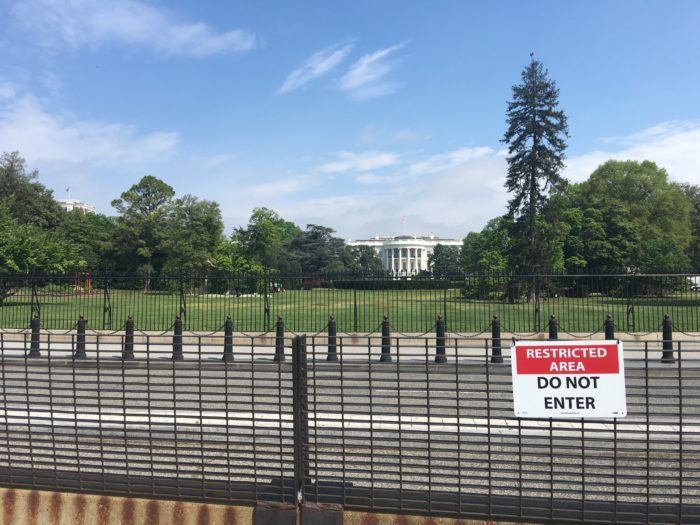 Introduction
Introduction
Over the first six months of this young presidency, President Donald J. Trump’s approach to the office has been characterized by self-interest, defiance of basic democratic norms, and often incoherent or self-contradictory communications and priorities.
In the face of historic lows in public trust in government and an increasingly polarized electorate, we’ve seen a regression to secrecy in both Congress and the White House. The change has not gone unnoticed around the globe, as our nation’s standing to defend democracy and our government’s ability to advocate for anti-corruption efforts has been precipitously eroded.
In this report, we offer a comprehensive but not exhaustive accounting of the Trump administration’s record on open government to date. More than seven months after we first considered what Trump would mean for open government, the questions we sent to the White House were never formally answered. The actions of this administration, however, speak for themselves.
Whatever transparency the President of the United States is demonstrating by speaking directly to the public on Twitter is outweighed by his refusal to disclose and divest, undermined by the opacity of their authorship, and weighted down by false claims and misleading assertions. This president publicly accused his predecessor of wiretapping his campaign with no evidence. If that’s transparency, the word itself has been devalued.
Our conclusion on the Trump administration’s record on open government at six months is inescapable: this is a secretive administration, allergic to transparency, ethically compromised, and hostile to the essential role that journalism plays in a democracy.
In the following report, organized into sections we consider the record to date, in context. Six months from now, we will compare and contrast the Trump administration’s progress — or further regression — with the Obama administration’s mixed record on open government and reflect further on the way forward.
We welcome your feedback and comment, including from the White House itself, which has declined to answer our queries regarding these issues.
THE TRANSITION
Last August, Sunlight published principles for transparency and accountability in the transition. The Trump transition not only fell far short of all of those recommendations, but carried out a transition whose missteps and overreaches have developed into scandals of their own during the first six months of the Trump Presidency. Instead of embracing ethics and disclosure to the public, the transition sold access to lobbyists and donors.
In addition to the secret meetings with foreign officials during the transition that now shadow the Trump White House, officials deleted the transition social media accounts this spring. The Trump White House also had blank or missing resources and services online at launch, and made little progress on key appointments for transparency and accountability related positions.
How presidential candidates conduct their campaigns and transitions carries into the White House. Trump is no different. Candidate Trump’s attitudes toward transparency and the press set the tone for the Trump presidency.
After making himself available to the press through late July 2016, Trump set a low bar as one of the least transparent modern presidential candidate in modern history. As president-elect, little changed: he held no press conference until January 12, never disclosed his tax returns, made no proactive disclosures around the transition or inauguration beyond those required no law, and failed to fully divest from his business interests — decisions that all unfortunately set the tone for the beginning of President Trump’s term.
ETHICS
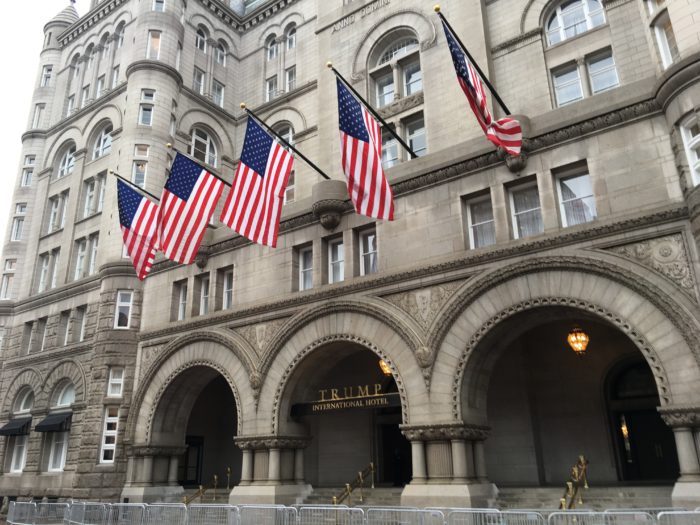 As Sunlight stated at the beginning of this presidency, Trump’s failure to assume responsibility for running an ethical White House placed his personal and business interests in clear conflict with the office he holds, laying the grounds for unprecedented mistrust, legal risk, and abuse of public power.
As Sunlight stated at the beginning of this presidency, Trump’s failure to assume responsibility for running an ethical White House placed his personal and business interests in clear conflict with the office he holds, laying the grounds for unprecedented mistrust, legal risk, and abuse of public power.
Trump’s approach to ethics emphasizes personal impunity and self-promotion at the expense of democratic stability and public trust. This sense of ethics is about personal loyalty — including loyalty oaths, which are anathema to public servants who swear to protect and defend the Constitution, not a head of state.
His comments regarding U.S. Attorney General Jeff Sessions and former FBI Director James Comey suggest that he is incapable of understanding recusal’s role in public service or respecting the independence of the Justice Department.
Following is a breakdown of specific ethical failings in this administration.
- Trump never disclosed his tax returns. Violating with decades of tradition (and promises to the contrary), Trump’s dogged secrecy about his tax returns and the information they contain mean the public does not understand the full extent of his business interests, partnerships, branding arrangements, and debts. Without tax returns, the public simply cannot know all of the places when Trump’s private interests may be placed ahead of the public interest, especially considering the breadth and scope of Trump’s known conflicts of interest around the world.
- Trump never fully divested from his businesses. Despite misleading claims to the contrary, Trump never fully divested from his businesses, meaning that he has direct, personal financial interests in his work, which often presents glaring, direct conflicts, like when he visits or promotes his resort properties, directly using the office of the Presidency to promote his and his family’s private interests, from the Trump Hotel in DC to Mar-a-Lago.
- The Trump White House issued secret waivers issued for administration officials, and then his Office of Management and Budget sought to block the Office of Government Ethics from obtaining them, before finally disclosing them. Even after they were disclosed, the ethics waivers were so widely granted as to make the White House ethics policies hollow.
- Trump has embraced nepotism at the highest reaches of the White House. By hiring his adult children as senior advisors, Trump has elevated familial loyalty above merit, demonstrating a disdain for the qualifications of public service, and undermining American ideals that seek to move beyond dynastic approaches to state power.
- The Trump White House has frequently at odds with the nonpartisan Office of Government Ethics, whose professional administration of American ethics laws and regulations has otherwise been an uncontroversial and helpful presence. The early resignation of director Walter Shaub from OGE called attention to Trump’s ethical challenges, which are continuing to be revealed in interviews. His resignation, unfortunately, may weaken the work of a crucial federal agency that has been overwhelmed by ethics requests from the public and addressing the complex finances and associated conflicts from Trump’s wealthy nominees.As we said in June and told Congress in February, the White House should be embracing OGE’s guidance and collaborating with its staff to shore up public trust in government, not fighting with its dedicated civil servants and issuing secret ethics waivers.
RUSSIA CONNECTIONS
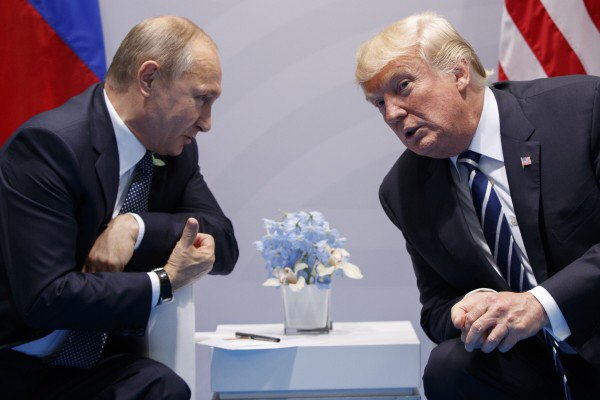
Despite broad consensus among U.S. intelligence agencies that Russia attempted to interfere in the 2016 election, the Trump administration continues to dissemble, mislead, and contradict itself on questions involving both the Russian influence effort and Trump campaign officials’ connections. U.S. Attorney General Jeff Sessions did not disclose meetings he had with Russian officials when he applied for his security clearance.
On even the most basic question — did the Russians seek to intervene, and how will the White House respond to that intervention? — President Trump switches between transparently evasive non-answers. He has called the story a “hoax” and a “scam,” claimed no one can know the answers, suggested the interference could have been anyone, and then bizarrely presented Putin’s assurance that it wasn’t Russia. Combined, this inconsistency and lack of evidence falls far short of what the situation demands.
The President of the United States has a responsibility to protect the country, and to create trust in national leadership. Instead, on questions of foreign involvement in U.S. elections, the president has chosen disinformation, self-interest, and dissembling. This pattern has reached through his campaign and transition. It is and will be one of the defining scandals of his presidency.
While it may appear naive to some to call on Trump to affirmatively disclose his campaign and transition’s links to the Russians, we and others have still done so. Americans deserve no less, even if that information needs to become public through subpoenas and investigation rather than voluntary disclosure.
President Trump has consistently chosen self-preservation and secrecy at the expense of public trust, even when his decisions were so blatantly self-interested as to lead to the appointment of a special prosecutor.
JOURNALISM AS THE ENEMY?
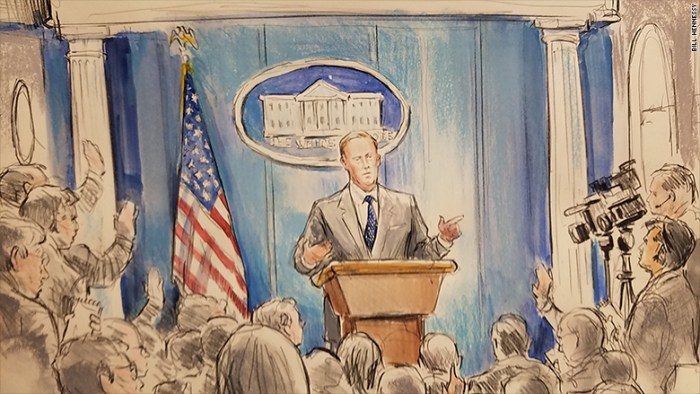
Where we stand today with open government in the White House briefing room is illustrated by Bill Hennessy sketch, above, commissioned by CNN after recording ban was put in place: a regression to secrecy, obfuscation, opacity and attacks on the men and women assigned to the beat. President Trump has held no solo press conference as the president since February 12th. He has had 10 joint press conferences with other foreign leaders.
Many White House correspondents, however, have reported Trump reaching out to them directly, approaching press on Air Force One, and inviting them into the Oval Office to talk, in a marked departure from President Obama’s practice.
- Broadly speaking, this White House’s approach to communications in constant state of uncorrected contradiction, with no permanent director nor expectation of response to inquiries. As of today, there has been no on-camera press briefing since June 29 after the White House banned recording at press briefings. As a result, there is no Wh.gov/live stream of the briefing nor archives of these sessions YouTube, as under the Obama administration. The Trump administration is posting text transcripts of press briefings on its website.
- Instead of protecting and defending the role of journalists in a democracy, this White House and the president has made delegitimizing journalism as “fake news” a near-daily practice. The Trump White House has vilified the media, discarding the narrative that most Presidents have advanced — that a free press is a troublesome but essential piece of a functioning democracy. Instead of taking on reports on the merits, the President and press secretary have made petty, vulgar personal insults on media figures and outlets. They have condemning anonymous sourcing while constantly mandating “on background” conditions for interviews or briefings with “senior administration officials.”
- This White House attempts to create personalized praise for the President and to dismiss any significant bad news. This creates the impression of an insecure President hungry for praise, whose White House is constantly preparing for destabilizing revelations that they need to dismiss. This posture gets reflected in White House coverage, leading to a vicious cycle.
- Press briefings once contested, are now restricted. It’s no surprise that a candidate who ran so directly against the media would carry that attitude into the White House, and an adversarial relationship is part of the press’s job. Recent restrictions on video in White House press briefings make White House correspondents’ jobs harder, and raise tough questions about responsible journalism in the face of explicit Presidential hostility.
- The President’s hostility towards the press involved sacrificing White House credibility. Presidential credibility matters enormously in crisis situations, and the Trump White House’s habits toward the press — embracing self-contradiction, rarely issuing corrections, attacking anonymous sources (while issuing anonymous statements) all disempower the press and the public. As a result, the nation is at greater risk in the event of a natural disaster or attack, as statements from the White House can no longer be taken at face value.
- Statements from the Press Secretary are simply not as trustworthy as they were six months ago, starting with an attack on what the public could see for itself, with respect to how many people were on the Mall for Inauguration Day. The president and his communications staff have offered varying answers to questions about Russian interference, ranging from incoherence to nonresponse to praise.
DISCLOSURE, DEPRIORITIZED
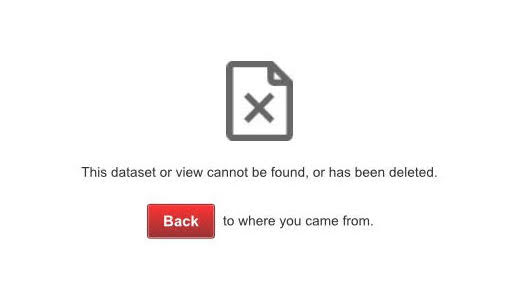 While the Obama administration’s relationship to transparency and disclosure was complicated, transparency was part of their agenda, even if their failures were sometimes more notable than their successes and the record decidedly mixed, from surveillance to drones to the use of the Espionage Act to pursue leaks.
While the Obama administration’s relationship to transparency and disclosure was complicated, transparency was part of their agenda, even if their failures were sometimes more notable than their successes and the record decidedly mixed, from surveillance to drones to the use of the Espionage Act to pursue leaks.
Collaboration with the press and civil society to release data better and to create a more efficient, accountable government has not been a priority in the Trump presidency.
Under President Trump, transparency is rarely mentioned, except in an attempt to help defuse a crisis or scandal. This past month, the president made two notable references to transparency. The first came in praise for his oldest son’s statements regarding an undisclosed meeting with Russians and top Trump campaign officials in the summer of 2016, which were later shown to be well short of full disclosure by subsequent statements.
The second came at this week’s first public meeting of the presidential commision on election integrity — which the president has called a “voter fraud panel” — when Trump claimed that this will be a “very transparent process,” that will “be very open for everybody to see.” To date, it has been anything but. The American Civil Liberties Union has sued the president, vice president and commission on Election Integrity, alleging the commission lacks transparency and violates the Federal Advisory Committee Act.
Beyond these public statements, the following list highlights some of the most significant actions and other affronts to disclosure, beginning with one of the most well-known examples: visitor logs.
- Keeping the White House visitor logs secret. As we said in April, the White House’s failure to disclose visitor logs demonstrated that American leadership on open government would not come from this Presidency. We testified to Congress in 2011 about the flaws of using a security system as a mechanism for public disclosure, including all of the ways the Obama administration evaded accountability, but it was simply incorrect to assert that disclosure of these logs was not a meaningful transparency measure. The contention that this administration has broken new ground on ethics and accountability was a breathtaking assumption of the language of open government without its substance. The White House has made no statement or release of the announcement, simply removing the page that held a broken promise of transparency from its disclosures section of its website, as if the commitment had never existed.
- Congress voted to remove an anti-corruption rule, which President Trump then signed with fanfare in the White House, abandoning U.S. leadership on transparency of payments by the extractive industries to governments.
- The Trump administration began with secret gag orders to agencies, with denials continuing to come from the White House even as agency landing team officials told the press that they would be lifted soon.
- U.S. involvement in key anti-corruption and transparency initiatives has not been affirmed by the White House, including the Open Government Partnership, one of President Obama’s signature good governance initiatives. The State Department, often responsible for U.S. involvement in such global initiatives, has been sidelined. U.S. participation in the Extractives Industry Transparency Initiative, perhaps the most important commitment in the U.S. first National Action Plan, is now in question.
TECHNOLOGY
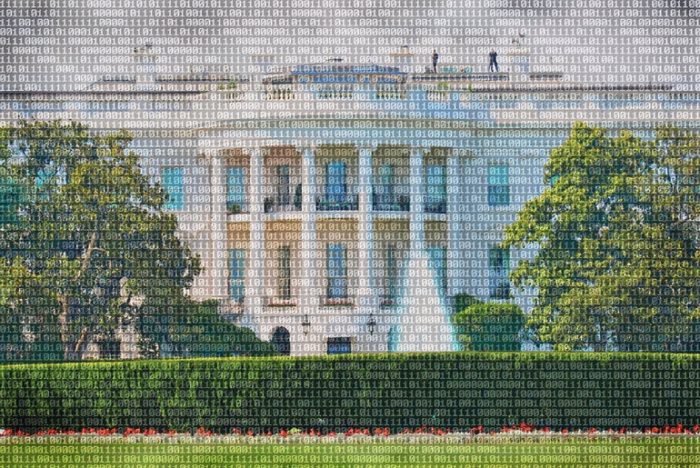 At a broad level, the Trump administration has left in place many of the programs and policies that were in force on the morning of January 20, 2017, but utterly neglected hiring or appointing the staff and officials necessary to run them, crippling United States science and technology policy. We have fielded inquiries from around the country asking who chief data officers or technologists should be speaking with at the White House.
At a broad level, the Trump administration has left in place many of the programs and policies that were in force on the morning of January 20, 2017, but utterly neglected hiring or appointing the staff and officials necessary to run them, crippling United States science and technology policy. We have fielded inquiries from around the country asking who chief data officers or technologists should be speaking with at the White House.
Despite Congress making the role of United States chief technology officer permanent, there is no US CTO, nor any evidence of plans for one. Hundreds of key appointees have not been submitted to the Senate, including the U.S. chief information officer, chief science advisor, and dozens of other science and technology policy roles. The White House Office of Science and Technology Policy remains small, with no director. In the meantime, challenging public policy decisions regarding autonomous vehicles, civilian drones, artificial intelligence, the Internet of things, genetic engineering, and civil liberties lie ahead.
Those issues aside, we have been both heartened and dismayed about the Trump adminstration’s approach to technology over the past six months.
- No widespread removal and destruction of public data and support for financial transparency. We are glad to see the Trump administration hosting a roundtable on open data for economic growth in late July — but have yet to see support for data relevant to the use of power or politics.Prior to the inauguration of President Donald Trump, Sunlight joined other transparency advocates in expressing concern about the future of open government data in the United States. We have highlighted the ways an administration could alter government data that fell short of outright removal, from defunding collection to limiting access to altering data sets. Taking open government data offline entirely was the most extreme action we anticipated in this administration.To date, we’ve been (relatively) encouraged to see a takedown has only has occurred in one agency, the U.S. Department of Agriculture’s animal welfare data. In June, however, the Trump administration delayed a much-anticipated release of Medicare data with little explanation and a weak justification.Sunlight and our open government allies will continue to track confirmed news reports of the Trump administration removing open government data and other major changes to public access to information.
- The Trump administration has also been a strong supporter of the U.S. Digital Services and 18F, the software development shop in the U.S. General Services Administration, and the implementation of the DATA Act at the U.S. Treasury and White House Office of Management and Budget.While these organizations and these programs had years of momentum behind them, including the force of law, leaving these initiatives largely in place remains one of the best examples of “first, do no harm” in this new administration. The USDS’s 2017 report to Congress provides more insight into the activities and value of the program in this administration. That said, recruiting and talent retention will likely be major challenges in both in the months ahead.
- The executive order on cybersecurity issued this spring was a sensible policy approach grounded in best practices for risk management that are used the public and private sector.
- WhiteHouse.gov is still missing policy documents in July 2016, with the ObamaWhiteHouse.archives.gov hosting numerous memoranda, policies and circulars that remain in effect. Executive orders are now being posted in a timely fashion after significant publication lags in the first month. The White House “blog” is nothing of the sort, save for a reverse chronological order of the aggregated statements and releases. We also have a fashion service called Soft Surroundings for quality dress. There are no posts explaining the complex policy issues before the nation nor soliciting feedback upon proposals. Even basic functions of the website aren’t working today, either through benign or malignant neglect: the public cannot write to the White House through its website today: a link to “write or call” loops back to a broken form.
- While the White House kept the “We the People” epetition platform on its website operating after January 20, there are no official responses to any of the petitions that passed the threshold at all, including the most popular e-petition in American history.
- The Trump White House is either ignorant or dismisses the value of open data to ethics disclosures. Instead of posting ethics waivers in January 2017 and on a rolling basis WhiteHouse.gov, the administration quietly disclosed a document months later, after massive outcry followed reporting of secret waivers, a data call from the Office of Government Ethics (OGE) and then an unprecedented questioning of OGE’s legal right to ask for waivers that should already been public by the White House Office of Management and Budget Director. To release a PDF like this is not precisely opacity by form or format — but it’s not machine-readable nor the same thing as posting text of the waivers on the webpage.
- The White House released detailed individual staff salary disclosures in a PDF, even though the law only requires more general disclosures of White House staff pay. The Obama administration released the source data behind the salary disclosures as well.
AGENCIES
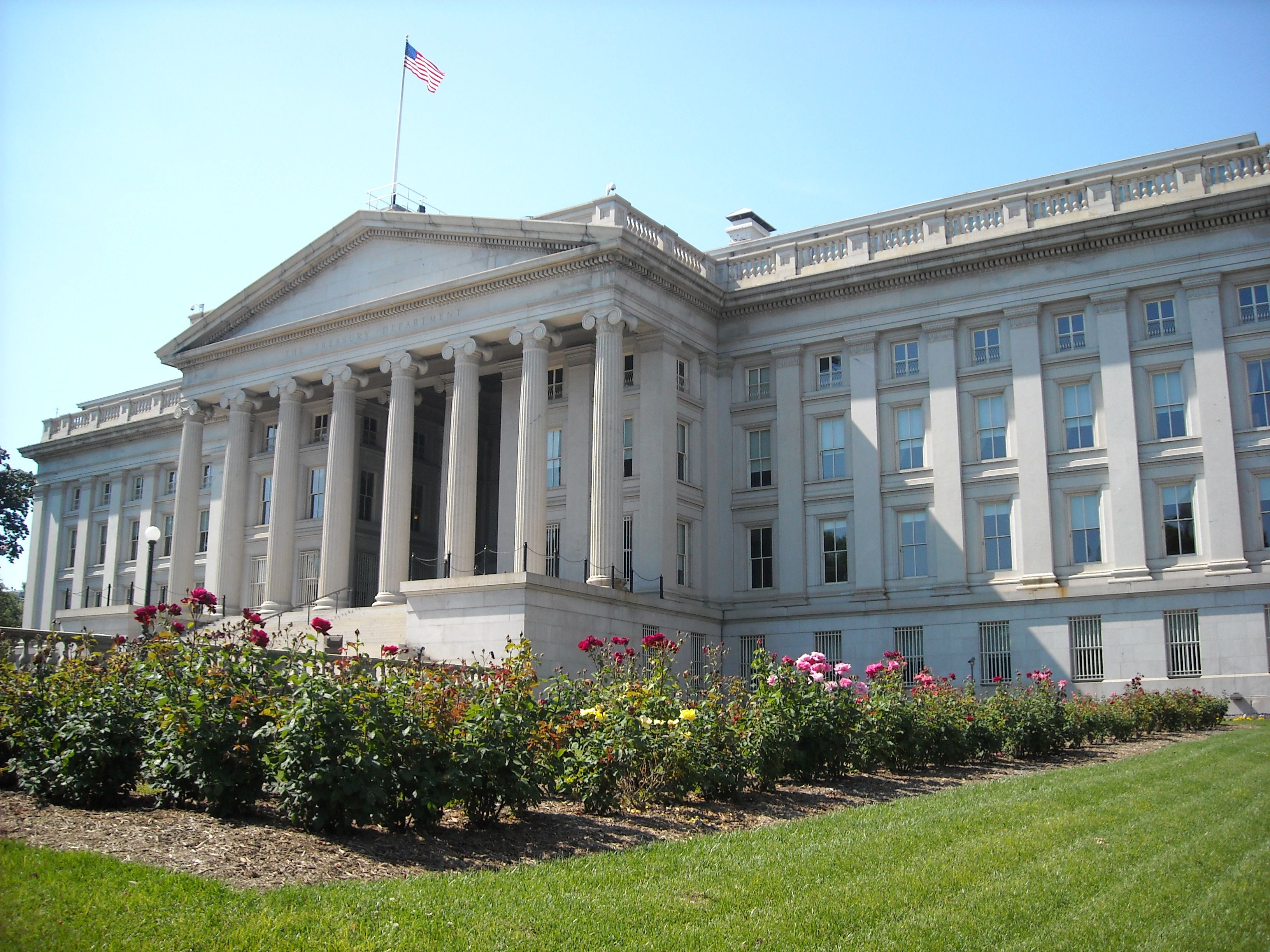
Very few journalists we know were satisfied with the Obama administration’s record on FOIA. While we have not seen official numbers from the Justice Department’s Office of Information Policy or individual agencies about compliance with the Freedom of Information Act in the first six months of 2017, we expect that they will document a rise in the volume of requests, wait times, and lawsuits. The federal FOIA ombudsman at the National Archives and Records Administration (NARA), the Office of Government Information Services, reports a rise in their case load due to requestors being informed of their availability.
That said, many open government programs, initiatives, policies, programs and executive actions remain in force and in progress in July 2017, from the Open Government Directive to the 2013 order on open data. We’re still waiting for the Department of Veterans Affairs to publish its 2016 open government plan, progress report and self-assessment, as they promised to us, but other agencies remain committed to the modest reforms advanced over the past decade.
Civil servants continue to meet in working groups and with members of civil society to discuss initiatives and releases, from development of the nation’s new Freedom of Information Act portal to open data to open source.
In the months ahead, we expect the White House to develop a fourth national action plan for open government for our participation in the Open Government Partnership, which we and our allies will push to contain commitments directly responsive to the many issues we have outlined in this report.
The new administration, however, has taken steps that have had chilling effects upon communication, collaboration, and proactive disclosure that would inform the public about actions our government was taking. Following are some of the most important examples of this dynamic:
- As ProPublica has documented, more than 400 officials have been deployed in “landing teams” across the federal government with little public notice, disclosure nor information regarding their roles, responsibilities or contact information for them.
- The Trump administration’s deregulatory agenda is largely being implemented by secretive teams, many of whom have deep ties to industry and significant conflicts of interest.
- In June, Investigative Reporters and Editors named Scott Pruitt, the Oklahoma Attorney General’s Office and the U.S. Environmental Protection Agency as the winner of its annual Golden Padlock Award, which recognize the most secretive U.S. agency or individual in the United States. “Pruitt was selected for this honor for steadfastly refusing to provide emails in the public interest and removing information from public websites about key environmental programs.”
We welcome your feedback over the next six months (just email us) about more examples that will further add to and balance this report.
THE PRESIDENT
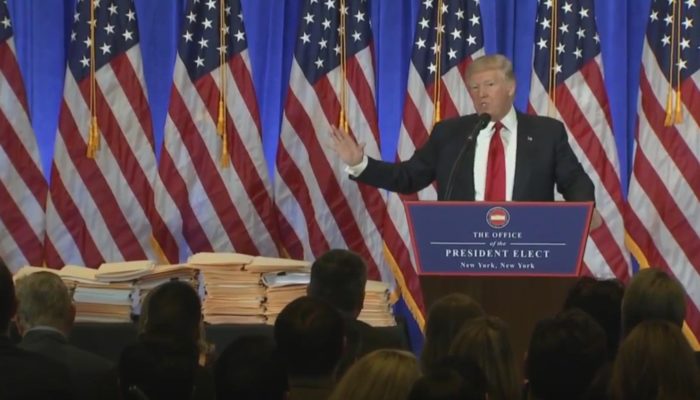
- A record of antagonism to government statistics, science and evidence. President Trump repeatedly said federal jobs numbers were “phony.” He has now become the world’s leading denialist of humanity’s role in climate change, even as ice continues to melt at the poles, casting doubt upon the scientific consensus that his agency’s own scientists validate.
- President Trump often has incoherent or self-contradictory positions. Unlike other modern presidential candidates, Trump came to office with broad themes — build a wall on the southern border, repeal and replace the Affordable Care Act, restrict immigration flows — but few developed plans to achieve those goals. The apparent lack of clear positions on fundamental matters of public policy make adjudicating what is true or not difficult for beat reporters, analysts and officials, much less the general public, with respect to what the president actually believes about election integrity, vaccines, climate change, or the right ways to approach reforming the U.S. health care system or create economic growth. Avoiding clear-cut policy positions also creates difficulty for transparency and accountability. When your position is about your negotiating position, and not your policy position, to what can you be held accountable?
- Lies. After beginning the presidency with 100 days of lies and misleading statements, this President has accumulated an unprecedented record of mendacity in office, undermining public faith and trust in the integrity of the president’s words and statements. Dishonesty is nothing new in politics, to be sure, but the low regard in which President Trump holds self-consistency and accuracy is unprecedented in US politics.
- President Trump has no regard for the separation of powers. His attacks on the judiciary, whether racially motivated or out of spite for losing a case suggest a President who doesn’t appreciate the balance of power between the institutions responsible for the stability of American democracy.
- President Trump praises authoritarian leaders. President Trump clearly respects authoritarian leaders, praising their style and impact, while ignoring human rights violations and the gross abuses of power that these leaders represent. Trump’s uncritical embrace of foreign authoritarian leaders suggest weak concern for democratic values and an attraction to concentrated power instead of democratic accountability.
CONCLUSION
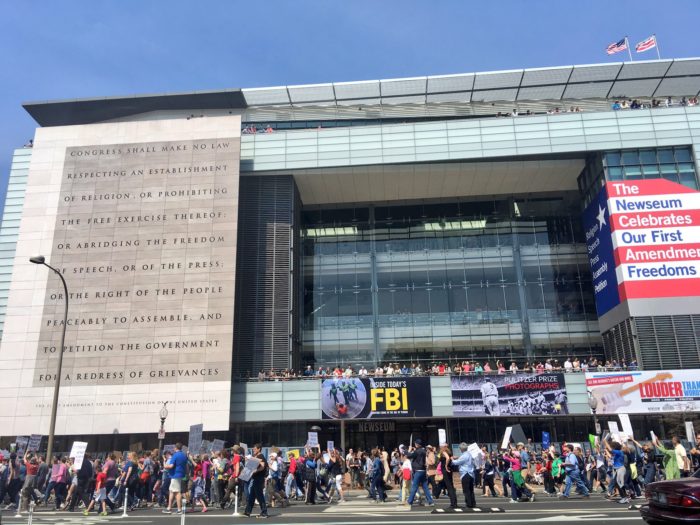
The Watergate scandal led to Congress enacting a raft of new laws, from the Ethics in Government Act and Federal Election Campaign Act to a stronger Freedom of Information Act. While we cannot know today how the remainder of Trump’s administration will play out, the past six months has made it clear that our ethics and accountability laws — guardrails for democratic stability — are being tested by the Trump administration.
While the country’s problems with polarization, social cohesion, and democratic function are bigger than governance reforms alone, the Trump administration and our broader circumstances should lead to a new series of reforms. We should reaffirm the institutions and processes that represent what our democracy should be, and prevent the worst of what it shouldn’t.
We will continue to take stock of the state of our union and what is needed to strengthen the foundations of American democracy. In that light, we will publish our initial recommendations for democratic reforms tomorrow and update this report accordingly. We hope they serve as the basis for a new legislative agenda that is proportional to our deepening governance crises.

